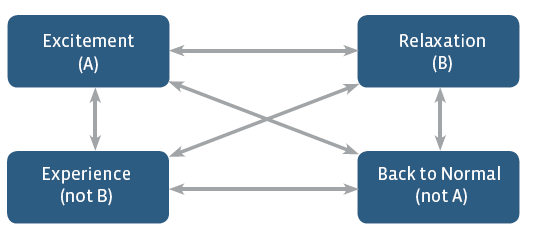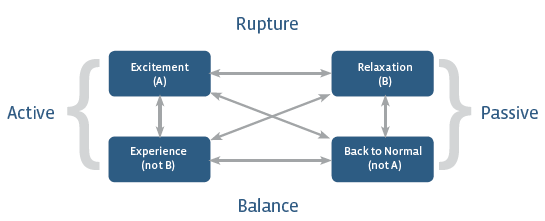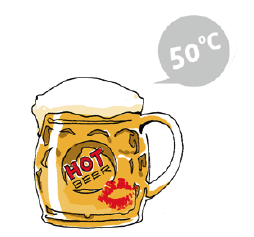

Marketing and branding professionals face a reoccurring question in today’s business world: How can my brand be differentiated from competitors and recognized by my target consumers? In the global marketplace there are countless brands all trying to sell their “unique” attributes in their respective product categories. Excessive benchmarking, gap analysis and studying of competitor brands often results in a multitude of similar products rather than the development of brands with truly novel features or expressions. So what can brand managers do to stay ahead of the pack when it comes to product innovation, especially when they want to stay true to an attribute that is shared by other brands in the industry? For one, they need to equip themselves with tools that can handle such complexity. At Labbrand, we feel one of these tools is semiotics.
Semiotics can be loosely described as the study of how meaning is made and understood through the interpretation of codes by individuals and groups. When applied to branding, semiotics is an analytical tool that can reveal how an attribute or concept such as indulgence or refreshment is expressed in a product category. Taken further this analysis can reveal industry or category trends in how the attribute is expressed and exposes empty space where brands can innovate a new expression of the meaning.
Furthermore, semiotics is regarded as an effective tool to understand the distinctive interpretation of meaning across different cultural contexts (see our previous article, Advertising Decoded). As many multinational companies have discovered in entering the Chinese market, a concept that is expressed a certain way in other parts of the world will be portrayed quite differently in China. For example, celebration may be communicated through images of a house party with a birthday cake in North America, whereas in China the same scene would involve a bowl of noodles with friends at a restaurant.
It may seem relatively easy to differentiate your brand if you want to call on an entirely new attribute that is not currently used by other brands. For example, the Axe brand deodorant spray differentiated itself by calling on sexual appeal rather than functional odor-fighting attributes as competitor brands did.
But what if you want to use an attribute that is shared by other brands, how then can your brand stand out? For example, Starbucks and Häagen Dazs brands both share the attribute of indulgence, yet they express them in different ways, so that they are not in direct competition with one another. Similarly, many car companies in China call on status appeals in their advertising and communication, causing a lack of differentiation. Concepts such as indulgence and status can be explored through semiotics to reach a differentiated brand positioning and distinctive brand communications.
In the beer industry, refreshment is an attribute that is commonly called on by multiple if not all brands. However, brands can express the attribute in a unique way. For example, one brand may portray refreshment through a pool party advertisement, while another beer brand conveys it through mountain scenery.
By using semiotics, innovative codes can be called on for communication that position the brand differently than its competitors. You can even go so far as to stretch or break existing codes while remaining true to the core attribute such as refreshment. A semiotic square enables this delicate brand innovation.
A semiotic square can be thought of as an analytical tool that deconstructs structures of meaning in a particular category. The underlying assumption of the semiotic square is that we often think of reality in terms of opposites: dark vs. light, serious vs. fun, formal vs. informal, etc. Meaning is then constructed surrounding contraries, contradictions, and implications between elements.
The starting point of semiotic analysis is information gathering. In this case the researcher compiled a variety of images from beer communication materials pertaining to refreshment. The square itself was then constructed when an initial opposition (A and B) was discovered, which in our example was Excitement and Relaxation. This opposition was fairly obvious when looking at the communication materials, but less apparent themes will be unveiled through analysis enabled by the semiotic square.
The next step is to come up with something that is “not B”, and then something that is “not A”. For example, “not-relaxation” is “experience”, and “not-excitement” is “back to normal”. The contradiction terms are larger than the initial opposition terms. “Not B” encompasses A, and “Not A” encompasses B; experience can include excitement, and getting back to normal can include relaxation. The semiotic square is more complex than this, with a possibility to create up to 8 new terms from a single opposition, but we will simplify here for the purpose of illustration.

Semiotic Square: Refreshment codes in Beer Communication
Let’s take a look at these elements separately. To understand each theme fully we need to consider how it fits into the daily life of the consumer. For example, excitement generated from a refreshing beer pushes you to do things you might normally do (i.e. it is not out of the ordinary, such as jumping in the air).

(source:google)
Refreshment can also cause relaxation, as evidences by these images of being in nature, chilling out, and laying back:

(source:google)
Under the experience theme the communication portrays consumers doing things they wouldn’t normally do. This can be seen in the picture of a man having a refreshing beer while enjoying nature or the girls spending time on a yacht.

(source:google)

In the experience area we found an example of code breaking, seen below:
This was an advertisement for non-alcoholic beer, making it suitable for drinking by pregnant women. This is a new experience, as usually women drink little or no beer when they are expecting. The somewhat shocking effect of the communication contributes to the brand’s differentiation and signals their positioning.
There is also the theme of getting back to normal, where enjoying a refreshing beer may help you forget your lousy boss or ex boyfriend, for example.

There are several other dimensions of the semiotic square. On the right and left hand poles a meaning that combines both themes can be realized. For example, excitement and experience are both active, whereas relaxation and back to normal are both passive.

Something that is neither passive nor active could be described as “rupture”, as in a break or change in the current state. This is often seen in beer commercials where the actor takes a refreshing sip of beer and the environment is transformed into a lively party scene. On the other pole, something that is both passive and active could be thought of as “balance”. This concept could be thought of as a navigation of the middle ground between activity and passivity, a compromise between soberness and intoxication. This could result in a negative outcome such as drinking and driving, which may be why this theme is rarely seen in brand communication.
Here we can see that the concept of refreshment within the beer category can be deconstructed into several themes. (The four we identified are not the only ones that could be found, if you started with a different contrariety other themes may surface).
If a beer brand wishes to call on the attribute of refreshment in their brand communication but wants to be innovative in the way it is expressed, they could explore one of these themes in more depth. The Nova Shin Brazilian beer is a case in point- images of pregnant women drinking beer will definitely draw attention and serve to differentiate the brand. It also signals the core idea or underlying positioning of the brand, that it is about the experience of drinking beer, not necessarily the behavioral effects of the alcohol. In the fast-paced modern lifestyle of cosmopolitan cities such as Shanghai, it is conceivable that more innovation could be done on the “back to normal” theme.
Going beyond only the codes called on for communication, a brand could pursue innovation surrounding the product itself. In the winter season, Chinese people often prefer to drink hot beverages as it is believed to be better for health. There are many hot teas, juices, milk beverages, and even hot soft drinks that are available at restaurants and convenience stores. When it comes to beer and refreshment, perhaps this concept could be realized through a hot beer served in the wintertime. Placing this beer in the warmer at the convenience store with the other hot drinks, having advertising emphasizing the experience of drinking warm beer in the winter, perhaps in a cozy home with snow falling outside, would all serve to differentiate that beer brand from competitors who were still portraying the cold refreshing sip of beer after a long day of work or to get the party started.

Semiotics, explored through methods like the semiotic square, proves invaluable for brand innovation and strategic planning. This approach is not only swift but also cost-effective compared to conventional market research. Beyond the capabilities of qualitative focus groups or quantitative surveys, semiotic analysis yields results with broader utility. Integrating the semiotic phase with other qualitative research methods enhances their overall effectiveness. For example, themes identified through semiotic analysis, such as those related to the concept of “refreshment,” can inform the preparation of focus group probe materials, shape questioning frameworks, and structure the interpretation of focus group outputs. This holistic approach contributes to a deeper and more insightful understanding of consumer perspectives, making it a powerful tool for brand development.
The semiotic analysis can also stand alone to guide brand positioning and differentiation on an attribute that is shared with competitor brands. In some ways, semiotics is a complex tool to understand and to use, but today’s brandscape is not only complex but also dynamic. Innovative methods are needed to generate novel and profitable results, and ultimately, to build strong brands.
A Labbrand Group Company © 2005-2024 Labbrand All rights reserved
沪ICP备17001253号-3* Will be used in accordance with our Privacy Policy
To improve your experience, we use cookies to provide social media features, offer you content that targets your particular interests, and analyse the performance of our advertising campaigns. By clicking on “Accept” you consent to all cookies. You also have the option to click “Reject” to limit the use of certain types of cookies. Please be aware that rejecting cookies may affect your website browsing experience and limit the use of some personalised features.